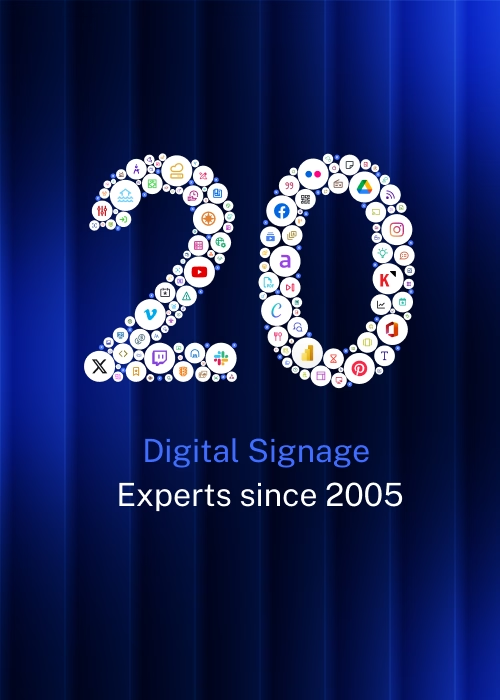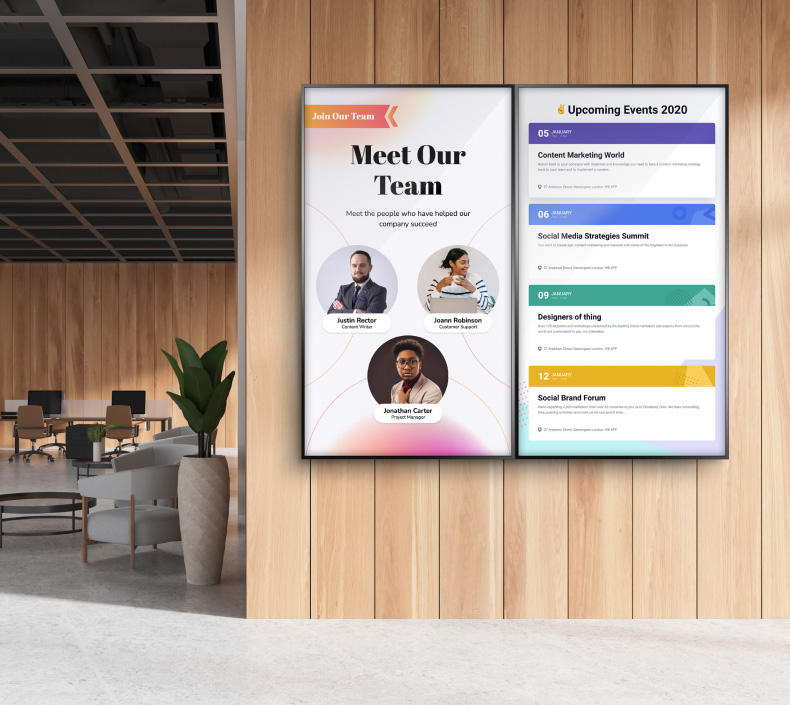The Role of Digital Signage in Modern Airports
Airports have evolved into complex hubs where efficiency and information dissemination are paramount. The role of digital signage in these environments is becoming more and more important to passengers by offering real-time information that enhances their travel experience. From guiding travelers through terminals to updating them on flight statuses, digital signage has become an integral part of modern airport operations. Among the most essential systems are Flight Information Display Systems (FIDS), Gate Information Displays (GIDS), and Baggage Information Displays (BIDS).
These systems ensure that passengers receive timely and accurate information, reducing stress and improving the overall airport experience.
Understanding Flight Information Display Systems (FIDS)
What is FIDS?
Flight Information Display Systems, or FIDS, are digital displays strategically placed throughout airports to provide passengers with up-to-date flight information. These systems serve as a centralized source of truth for travelers, offering details such as flight numbers, destinations, departure and arrival times, and gate assignments. By presenting this information clearly and concisely, FIDS help passengers navigate the airport with confidence, minimizing confusion and delays.
Evolution of FIDS
The evolution of FIDS has been marked by significant technological advancements. Traditionally, airports relied on static boards or manually updated screens to display flight information. However, as the volume of air traffic increased and passenger expectations grew, these methods became inadequate.
Today, digital displays have replaced these outdated systems, offering dynamic and real-time updates. The integration of advanced technology, such as networked systems and data feeds, has transformed FIDS into a powerful tool for managing airport operations. This evolution has not only improved the accuracy of flight information but also enabled airports to provide a more responsive and adaptable service to passengers.
Benefits of Digital FIDS
The transition to digital FIDS has brought numerous benefits to both airports and passengers. One of the primary advantages is the ability to provide real-time updates with a high degree of accuracy. As flight schedules can change rapidly due to various factors, the need for timely information is critical. Digital FIDS ensure that passengers are always informed of the latest developments, reducing uncertainty and enhancing the overall travel experience.
Additionally, digital FIDS offer seamless integration with other airport systems. This interconnectedness allows for the automatic updating of information across multiple platforms, ensuring consistency and reliability. For instance, changes in gate assignments or delays are instantly reflected on all relevant displays, providing passengers with a cohesive and efficient information flow.
Gate Information Displays (GIDS)
Introduction to GIDS
Gate Information Displays, or GIDS, are specialized digital screens located at or near boarding gates. These displays provide passengers with specific details about their flight, including boarding times, gate numbers, and any last-minute changes. The primary function of GIDS is to ensure that passengers have the most up-to-date information as they prepare to board their flights.
The accuracy of gate information is crucial in preventing boarding mishaps and ensuring a smooth transition from the terminal to the aircraft. In an environment where time is of the essence, GIDS play a vital role in keeping passengers informed and reducing the likelihood of missed flights.
Features of Modern GIDS
Modern GIDS are equipped with a range of features designed to enhance passenger convenience and streamline airport operations. Among the most important is the ability to provide real-time flight status updates. Whether a flight is boarding, delayed, or canceled, this information is immediately displayed on GIDS, allowing passengers to adjust their plans accordingly.
Another key feature of GIDS is their integration with FIDS. This interconnectedness ensures that gate-specific information is consistent with the broader flight data available throughout the airport. For example, if a flight's gate changes, both the FIDS and GIDS will reflect this update simultaneously, minimizing confusion for passengers.
Features of Modern GIDS:
- Real-time flight status updates (boarding, delayed, canceled).
- Seamless integration with FIDS for consistent information sharing.
- Visual and audio cues to alert passengers of important updates.
These features make GIDS an indispensable tool for managing the flow of passengers within the airport, reducing stress, and improving the overall travel experience.
Enhancing Passenger Experience with GIDS
The implementation of GIDS has had a profound impact on the passenger experience, particularly in terms of reducing stress and enhancing convenience. By providing clear and accurate information at the gate, GIDS help passengers feel more confident about their travel plans. This is especially important in large or unfamiliar airports, where navigating to the correct gate can be challenging.
Case studies have shown that airports with well-implemented GIDS report higher levels of passenger satisfaction. For instance, airports that utilize GIDS to provide real-time boarding information have seen a reduction in the number of missed flights, as passengers are better informed and can plan their time more effectively. This not only benefits the passengers but also contributes to smoother airport operations.
Baggage Information Displays (BIDS)
Introduction to BIDS
Baggage Information Displays, or BIDS, are digital screens located in baggage claim areas, providing passengers with real-time updates on the status of their luggage. BIDS are essential for ensuring that passengers are informed about where and when their baggage will be available for pickup, thus facilitating a smoother and more efficient baggage claim process.
The role of BIDS in the passenger journey cannot be overstated. After a long flight, the last thing passengers want is uncertainty about the whereabouts of their luggage. BIDS provide clarity and reassurance by displaying accurate information about the arrival and location of bags, thereby reducing anxiety and enhancing the overall travel experience.
Key Features of BIDS
BIDS are designed to deliver precise and timely information to passengers, which is crucial in a busy airport environment. One of the most important features of BIDS is their ability to provide real-time baggage status updates. This includes information on which carousel the luggage will arrive at, estimated arrival times, and notifications of any delays or issues.
Additionally, BIDS are often integrated with FIDS and other airport management systems. This integration ensures that any changes in flight status, such as delays or early arrivals, are reflected in the baggage information. This interconnected approach enhances the accuracy and reliability of the information provided to passengers.
Key Features of BIDS:
- Real-time baggage status updates, including carousel numbers.
- Integration with FIDS for consistent and accurate information.
- Notifications of delays or issues with baggage handling.
These features make BIDS a critical component of modern airport operations, significantly improving the efficiency of baggage claim processes and reducing the incidence of lost luggage.
The Impact of BIDS on Airport Operations
The introduction of BIDS has had a substantial impact on airport operations, particularly in the area of baggage handling. By providing real-time information, BIDS help streamline the baggage claim process, allowing passengers to retrieve their luggage more quickly and with less confusion. This efficiency not only enhances the passenger experience but also reduces the workload for airport staff, leading to cost savings and improved operational efficiency.
Moreover, BIDS play a crucial role in reducing the incidence of lost or mishandled baggage. By ensuring that passengers are informed about the status and location of their luggage, BIDS help minimize errors and improve overall satisfaction with the baggage claim process.
The Integration of FIDS, GIDS, and BIDS in Modern Airports
Interconnected Systems
In modern airports, the integration of FIDS, GIDS, and BIDS is essential for creating a seamless and efficient passenger experience. These systems are interconnected, meaning that changes in one area, such as a flight delay, are automatically reflected across all relevant displays. This interconnectedness ensures that passengers receive consistent and accurate information, regardless of where they are in the airport.
The integration of these systems also contributes to overall airport efficiency. For example, by linking FIDS with GIDS and BIDS, airports can provide a more cohesive information flow, reducing the likelihood of passenger confusion and improving the overall travel experience. This interconnected approach is particularly beneficial in large airports, where the volume of passengers and flights can make information management challenging.
The Role of Digital Signage Software
The successful implementation of FIDS, GIDS, and BIDS relies heavily on advanced digital signage software. This technology allows airports to manage and update displays in real time, ensuring that passengers always have access to the latest information. Additionally, digital signage software enables the integration of various data sources, such as flight schedules, weather updates, and security alerts, into a single, unified display system.
As airports continue to evolve, the role of digital signage software will become increasingly important. Future trends in this area include the use of cloud-based systems, which offer greater flexibility and scalability, as well as the integration of artificial intelligence (AI) to enhance the accuracy and relevance of the information displayed.
Future Trends in Airport Digital Signage
AI and Predictive Analytics
One of the most exciting trends in airport digital signage is the incorporation of AI and predictive analytics. These technologies have the potential to revolutionize how FIDS, GIDS, and BIDS operate by providing more accurate and timely information. For example, AI could be used to predict flight delays based on weather patterns or air traffic conditions, allowing airports to update displays proactively rather than reactively.
AI could also enhance the personalization of digital signage, tailoring information to individual passengers based on their preferences or travel history. This level of customization could further improve the passenger experience, making airport navigation more intuitive and stress-free.
Personalized Passenger Experiences
As digital signage technology advances, there is increasing potential for creating personalized passenger experiences in airports. Imagine a scenario where a traveler receives customized information on digital displays tailored to their specific flight, gate, or even personal preferences. This could be achieved through integration with mobile devices, where passengers opt-in to receive personalized updates as they move through the airport. For instance, a traveler might receive notifications about nearby dining options that align with their preferences or alerts about flight status changes directed specifically to their path in the airport.
Personalized digital signage could also assist passengers with special needs, such as those requiring wheelchair assistance or those with limited language proficiency. By offering content in multiple languages or highlighting accessibility routes, airports can create a more inclusive and supportive environment. This approach not only enhances convenience but also builds loyalty among travelers, who appreciate the attention to their individual needs.
Sustainability and Energy Efficiency
As airports strive to become more environmentally conscious, sustainability is becoming a critical factor in the design and implementation of digital signage. The future of airport digital signage lies in eco-friendly solutions that reduce energy consumption and minimize the environmental impact of airport operations.
One such innovation is the use of energy-efficient LED displays, which consume less power compared to traditional LCD screens. Additionally, advancements in solar-powered signage are emerging, allowing airports to harness renewable energy sources to power their digital displays. This not only reduces the carbon footprint of airports but also aligns with broader sustainability goals.
The Importance of Integrated Digital Signage Systems in Modern Airports
The integration of Flight Information Display Systems (FIDS), Gate Information Displays (GIDS), and Baggage Information Displays (BIDS) represents a critical advancement in modern airport operations. These interconnected systems are designed to work seamlessly together, ensuring that passengers receive accurate and timely information at every stage of their journey.
The future of digital signage in airports is poised for even greater advancements, driven by technologies such as AI, predictive analytics, and sustainable practices. As these systems continue to evolve, they will play an increasingly important role in shaping the passenger experience, making air travel more efficient, personalized, and environmentally friendly. In a world where information is key to a smooth travel experience, the importance of well-integrated digital signage systems cannot be overstated. These systems are not just about providing information—they are about transforming the airport experience into one that is seamless, stress-free, and tailored to the needs of each individual traveler.







